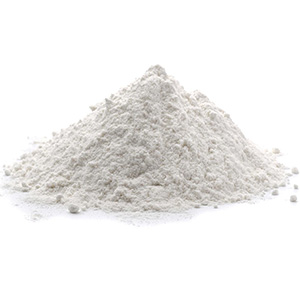
TiO2 --- 79.87 --- 13463-67-7
Titanium Dioxide contains not less than 99.0 percent and not more than 100.5 percent of TiO2, calculated on the dried basis. If labeled as attenuation grade, then Titanium Dioxide contains not less than 99.0 percent and not more than 100.5 percent of TiO2, calculated on the ignited basis. Attenuation grade material may contain suitable coatings, stabilizers, and treatments to assist formulation.
Labeling: If intended for UV-attenuation, the material must be labeled as attenuation grade. If intended for UV-attenuation, and any added coatings, stabilizers, or treatments are used, the labeling shall include the name and amount of the additives.
Identification: To 500 mg add 5 mL of sulfuric acid, and heat gently. After fumes of sulfur trioxide appear, continue heating for a minimum of 10 seconds. Cool the suspension, and cautiously dilute with water to 100 mL. Filter, and to 5 mL of the clear filtrate add a few drops of hydrogen peroxide TS: a yellow-red to orange-red color develops immediately.
Loss on drying: Dry it at 105 for 3 hours: it loses not more than 0.5% of its weight.
Loss on ignition: Ignite 2 g, previously dried and accurately weighed, at 800 ± 25 to constant weight: it loses not more than 0.5% of its weight. If labeled as attenuation grade, ignite 4 g of titanium dioxide, accurately weighed, at 800 ± 25 to constant weight: it loses not more than 13% of its weight.
Water-soluble substances: 0.25%.
Acid-soluble substances: 0.5%.
Arsenic: The limit is 1 ppm.
TiO2 --- 79.9 --- 13463-67-7
Action and use:
Protective; excipient.
DEFINITION
Content:
98.0 per cent to 100.5 per cent.
CHARACTERS
Appearance: White or almost white powder.
Solubility: Practically insoluble in water. It does not dissolve in dilute mineral acids but dissolves slowly in hot concentrated sulphuric acid.
IDENTIFICATION
A. When strongly heated, it becomes pale yellow; the colour disappears on cooling.
B. To 5 ml of solution S2 (see Tests) add 0.1 ml of strong hydrogen peroxide solution R . An orange-red colour appears.
C. To 5 ml of solution S2 add 0.5 g of zinc in granules. After 45 min, the mixture has a violet-blue colour.
TESTS
Solution S1:
Shake 20.0 g with 30 ml of hydrochloric acid for 1 min. Add 100 ml of distilled water and heat the mixture to boiling. Filter the hot mixture through a hardened filter paper until a clear filtrate is obtained. Wash the filter with 60 ml of distilled water and dilute the combined filtrate and washings to 200 ml with distilled water.
Solution S2:
Mix 0.500 g (m g) with 5 g of anhydrous sodium sulphate in a 300 ml long-necked combustion flask. Add 10 ml of water and mix. Add 10 ml of sulphuric acid and boil vigorously, with the usual precautions, until a clear solution is obtained. Cool, add slowly a cooled mixture of 30 ml of water and 10 ml of sulphuric acid, cool again and dilute to 100.0 ml with water.
Appearance of solution:
Solution S2 is not more opalescent than reference suspension and is colourless.
Acidity or alkalinity:
Shake 5.0 g with 50 ml of carbon dioxide-free water for 5 min. Centrifuge or filter until a clear solution is obtained. To 10 ml of the solution add 0.1 ml of bromothymol blue solution. Not more than 1.0 ml of 0.01 M hydrochloric acid or 0.01 M sodium hydroxide is required to change the colour of the indicator.
Water-soluble substances:
Maximum 0.5 per cent.
Antimony: Maximum 100 ppm.
Arsenic:
Maximum 5 ppm.
Barium: To 10 ml of solution S1 add 1 ml of dilute sulphuric acid. After 30 min, any opalescence in the solution is not more intense than that in a mixture of 10 ml of solution S1 and 1 ml of distilled water.
Iron:
Maximum 200 ppm.
Heavy metals: Maximum 20 ppm.
TiO2 Formula wt 79.90
INS: 171 CAS: [13463-67-7]
DESCRIPTION
Titanium Dioxide occurs as a white, amorphous powder. It is prepared synthetically. It is insoluble in water, in hydrochloric acid, in dilute sulfuric acid, and in alcohol and other organic solvents. It dissolves slowly in hydrofluoric acid and in hot sulfuric acid.
Function: Color.
REQUIREMENTS
Identification: Add 5 mL of sulfuric acid to 500 mg of sample, heat gently until fumes of sulfur trioxide evolve, continue heating for at least 10 s, and cool. Cautiously dilute to about 100 mL with water, and filter. Add a few drops of hydrogen peroxide TS to 5 mL of the clear filtrate. A yellow-red to orange-red color appears immediately.
Assay: Not less than 99.0% and not more than 100.5% of TiO2, after drying and after correcting for any aluminum oxide and/or silicon dioxide found to be present in the sample.
Acid-Soluble Substances: Not more than 0.5%.
Aluminum Oxide and/or Silicon Dioxide: Not more than 2.0%, either singly or combined.
Antimony: Not more than 2 mg/kg.
Arsenic: Not more than 1 mg/kg.
Lead: Not more than 10 mg/kg.
Loss on Ignition: Not more than 0.5% after drying.
Mercury: Not more than 1 mg/kg.
Water-Soluble Substances: Not more than 0.3%.